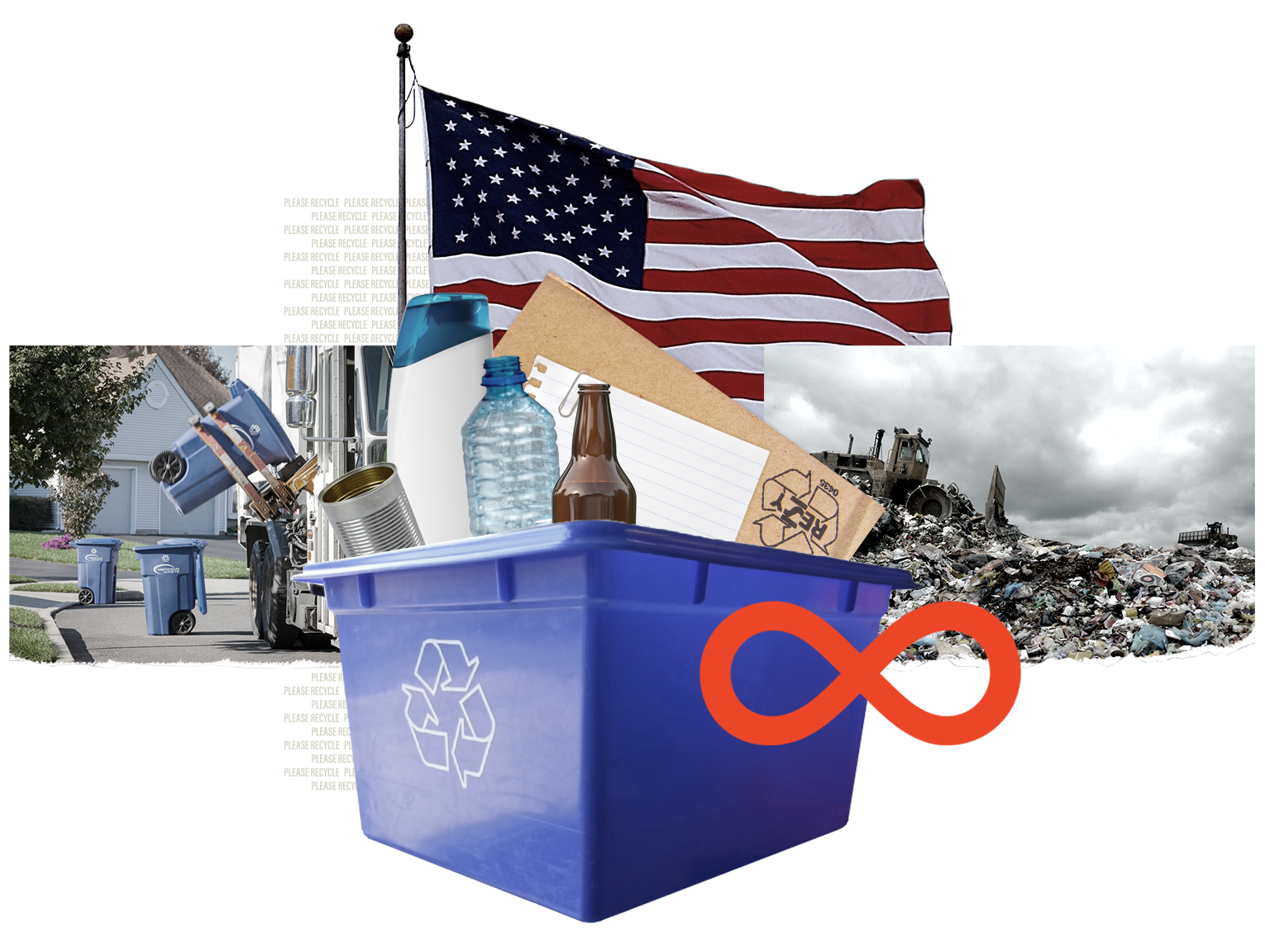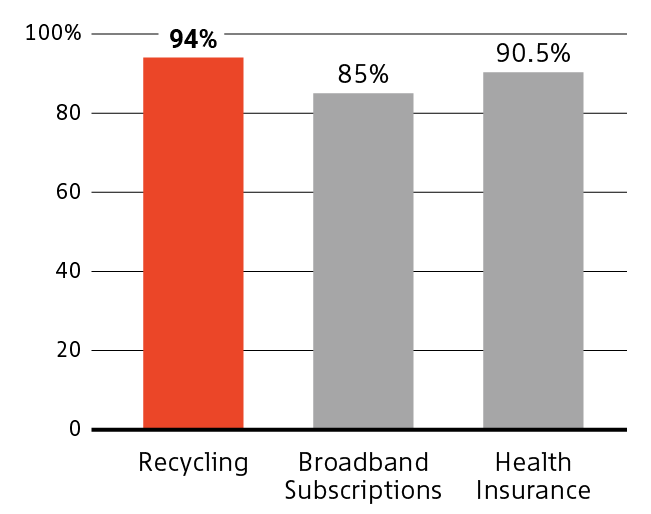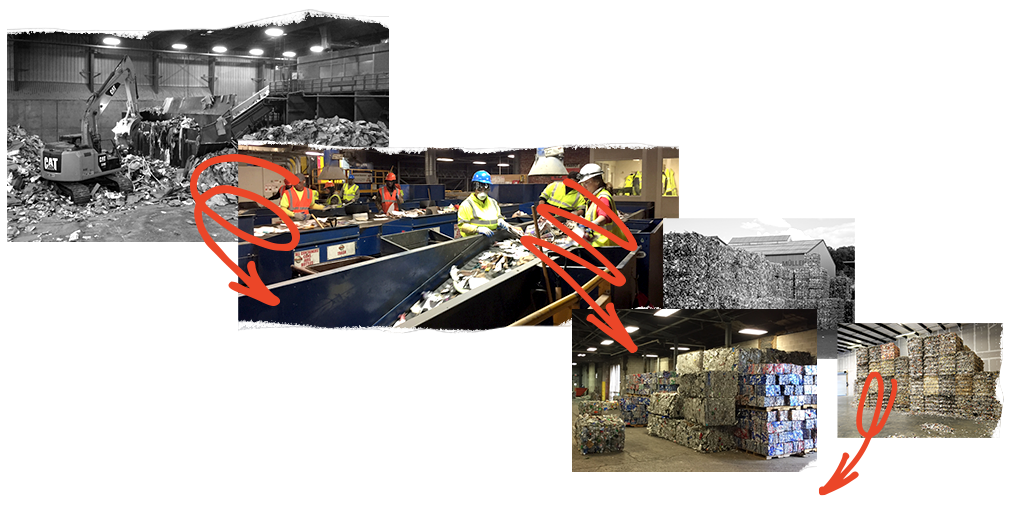Chapter 1
Recycling in America.

What kind of recycler are you?
Are you the casual recycler, who only recycles when it’s convenient, knowing that you could probably do more? Or are you a dedicated recycler, who aspires to recycle as much as possible, so at the end of the week, your recycling bin is more full than your trash can? Maybe you’re the third kind – the evangelist – the true believer whose mission in life is to convince others to be better recyclers.
Regardless of which type of recycler you are, if you live in America, you’ve probably learned about the benefits of recycling. You’ve probably internalized the idea that recycling is the best way for you to do your part to protect the planet from litter and excess waste.
Recycling is more popular than the internet.
Okay, not exactly. But according to 2020 report by the Recycling Partnership, a leading recycling advocacy group, 94 percent of Americans have regular access to recycling services (Mouw). That’s more than those with broadband internet subscriptions, at 85 percent (US Census Bureau), or who have health insurance, at 90.3 percent (Department of Health and Human Services).
So if recycling is so popular, it must provide significant benefits for the common good, right?
Percentage of Americans with access to recycling, broadband internet subscriptions and health insurance

Sources: The Recycling Partnership, the 2020 US Census, and the Department of Health and Human Services.
The alleged benefits of recycling.
Recycling advocates often promote the following benefits to justify the cost and effort it takes to make recycling work (paraphrased from the EPA’s “Recycling Basics”).
- Recycling reduces waste and conserves natural resources
- Recycling saves energy and prevents pollution
- Recycling provides jobs and other economic gains

An overview of the American recycling system.
A variety of recycling systems are used to capture discarded materials from economic activities in America. Recycling exists in multiple forms across sectors, and often occurs out of sight of American consumers. This project focuses on the most visible type: municipal recycling.
In America, municipal recycling is generally considered to be a public service that is funded by taxpayers, user fees, or a combination of the two (Mouw). American municipal recycling systems are generally aimed at collecting discarded materials from consumer products and packaging.
Depending on where you live, municipal recycling is provided as a curbside service, where trucks come to your house to collect materials, or as a voluntary drop-off format where consumers take recyclables to receptacle at designated locations.
When you put recyclables in the bin, they are collected and transported to a materials recovery facility (MRF)–known as a “merf” in the waste-management business–to be sorted by material type. After sorting, MRFs offer bales of materials for sale to reprocessing companies to be cleaned and processed back into raw materials.
USA: not number one at recycling.
On the global stage America excels at a lot of things, but not recycling. The average recycling rate in America hovers around 30 percent (EPA). This rate includes data on “consumer waste” – common household trash like containers and packaging, and other items like yard trimmings, furniture, and appliances. It does not include construction and demolition debris, sludges from wastewater treatment facilities, or industrial waste (EPA).
Compared to countries like Germany and South Korea, with recycling rates of 68 and 59 percent, respectively, the U.S. doesn’t recycle very well (OCED). On a global scale, the U.S. doesn’t even make the top-ten list of best recycling countries.
Unlike many European or Asian countries with robust recycling cultures, the American recycling system is not a cohesive, singular program operating under a unified set of standards. Instead, a patchwork of thousands of thousands of recycling programs work independently to collect recyclables and manage the materials. Because of this decentralized configuration, recycling guidelines in America vary depending on where you live.

Materials commonly accepted for municipal recycling in America.
Although specific recycling guidelines vary based on where you live, American recycling programs typically collect four broad types of materials from containers and packaging products: glass bottles and jars, aluminum and steel cans, paper and cardboard, and plastic bottles (ASTRX, Mouw).
The system is limited to accepting only a small proportion of the nation’s total waste output.
Although recycling is very popular in America, the current system is rather limited in its ability to reduce waste. Even if the average recycling rate were a perfect 100 percent, at best, municipal recycling would handle only one-third of America’s trash.
To understand why, let’s take a look at how the EPA divides municipal waste into three broad categories based on the types of goods that are thrown away (EPA).
First is the durable goods category, which applies to products that usually last three years or longer, such as major appliances and furniture. Nondurable goods like clothing, footwear, and household linens typically have a lifespan of three years or fewer. The third category is containers and packaging. Products in this category are usually thrown away within a year of being purchased.
The American recycling system was designed to collect waste from the containers and packaging category only, which in 2018, was 28 percent of the country’s annual municipal solid waste (EPA). Waste from the other two categories, durable and nondurable goods made up the remaining two-thirds of America’s trash.
Major categories of goods in America’s trash (municipal solid waste) in 2018.

Recycling is a distraction.
Despite its widespread popularity, the U.S. recycling system wasn’t designed to solve America’s waste and pollution problems. In fact, the system wasn’t really “designed” at all – it emerged around the 1970s after decades of legal battles between state legislatures and manufacturers over whether to regulate disposable beverage container waste (Elmore, Jaeger, MacBride). Manufacturers sold recycling as a sensible and environmentally beneficial alternative to regulations, and America bought into the idea (Elmore, Jaeger).
Since the 1970s, recycling has enabled manufacturers to shift the costs of managing trash onto the American people and municipal governments. As long as Americans believe recycling delivers meaningful environmental benefits, companies are free to produce billions of disposable, waste-generating products every year, without much scrutiny.
In the following chapters, The Recycling Distraction will show how recycling distracts Americans from three key issues related to waste, pollution, and environmental responsibility:
- Chapter 2: The environmental benefits of recycling are misunderstood and overrated.
- Chapter 3: Recycling helps manufacturers avoid environmental responsibility.
- Chapter 4: Recycling alone won’t stop America from drowning in plastic waste.
Afterward, the project will propose a path forward for addressing these concerns in the future.
Introduction
Chapter 2: The environmental benefits of recycling are misunderstood and overrated.
